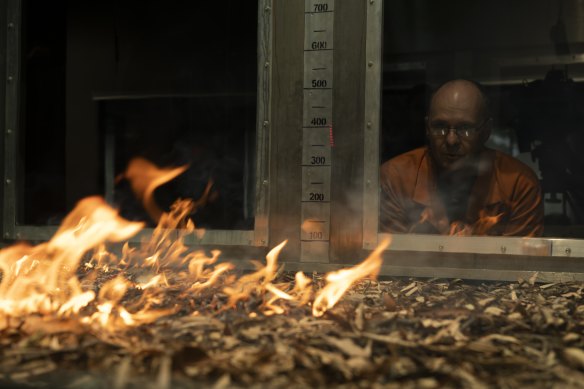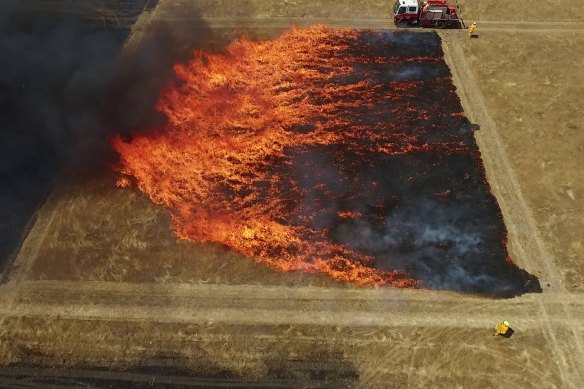2023-10-03 06:42:28
RFS AI tool Athena to help save homes, lives
The new fire modelling system Athena maps and predicts where bushfires are likely to spread, and automatically detects the lives and properties that may stand in a fire’s destructive path.
On Sunday, the start of the bushfire season, Athena’s map flashed with rippling purple pixels as the system simulated more than 85 blazes ripping through grass and bushland sapped by the hottest September on record.
After a trial run last year, the NSW Rural Fire Service is firing up a fully operational Athena for the first time to prepare for the worst bushfire season since Black Summer of 2019-20. At times during that season, 200 bushfires seared the state at the same time.
Athena’s ability to rapidly evaluate a fire’s severity, behaviour and threat to homes is designed to help the NSW Rural Fire Service decide where to deploy trucks, aircraft and personnel on those horror bushfire days.
The system highlights houses, nursing homes, schools and critical infrastructure such as powerlines at risk, and automatically ranks which bushfires require critical attention.
 Get a Free Speed Boost on Your Internet Connection: The One Surprising Trick Virgin Media Users Need to Try Now
Get a Free Speed Boost on Your Internet Connection: The One Surprising Trick Virgin Media Users Need to Try NowThe Pyrotron: Wrangling data from the flames
Athena’s fire prediction is partly underpinned by the CSIRO’s fire behaviour model Spark, which uses data gleaned from Dr Andrew Sullivan’s decades of controlled incineration experiments.
Sullivan, the leader of the CSIRO Bushfire Behaviour and Risks team, has spent decades running fire trials to test how wind, moisture and vegetation type affect how a lick of flame can roar into a deadly blaze.
Many of those have taken place in the Pyrotron, a 29-metre steel tunnel with a two-tonne wind turbine that can hold batches of burning bushfire fuel under controlled circumstances to extract sterile data from one of nature’s most chaotic forces.

Sullivan’s lab also runs field experiments. Those studies have yielded the fire danger rating system, used until its first overhaul in half a century last year, and made breakthroughs that revealed experts had drastically underestimated how rapidly large bushfires spread compared to smaller blazes.
The fire lab also developed a rule of thumb firefighters could use on the ground to roughly calculate the speed of fire spread.
 Is your Wi-Fi speed being murdered? The common mistake all BT broadband users must check today
Is your Wi-Fi speed being murdered? The common mistake all BT broadband users must check today“You can approximate the spread of the fire as being a fraction of the open wind speed,” Sullivan said. “In forests that’s about 10 per cent of the open wind speed, and in grass it’s 20 per cent.”

Despite these findings, field studies on fire are hard to replicate because scientists cannot control the weather. Varying wind, rain and humidity dashes the chance to keep variables steady in the field, a problem the Pyrotron solves.
“It’s about providing a way to study the combustion of bushfire fuels in a safe and repeatable manner that builds statistical robustness in our results,” Sullivan said.

With the Pyrotron, the fire lab has helped pinpoint the different ways fire behaves in eucalypt forests, wheat fields, paddocks and pine plantations, boosting researchers’ capacity to simulate bushfire spread with mathematical models.
 A Disturbing Bug in a Popular Android App Has Led Google to Take Drastic Action: Check Your Phone Now!
A Disturbing Bug in a Popular Android App Has Led Google to Take Drastic Action: Check Your Phone Now!“The fastest fire we’ve had in the Pyrotron over a five-metre length was 13 seconds, go to whoa. It was very, very fast and the wind speed wasn’t overly quick,” Sullivan said. “It was a bit of a blow because it was in standing grass that we’d been growing for months, and it was over and done with in a blink of an eye. Together, the field work and the laboratory work help us build the foundational knowledge necessary to improve our operational models that people like the RFS use.”
Fire behaviour predictor’s first time in the field
Dr Mahesh Prakash has overseen the CSIRO’s bushfire simulator Spark develop over six years, in collaboration with Sullivan’s team.
Once only useful for mocking up theoretical fires or planning hazard reduction burns, the model is now ready to map live bushfires and peer into the future of the flames.
“It’s transitioned from a research tool, to a risk assessment tool, to an operational tool. Now it can be used during a real bushfire. This is the first fire season where the agencies are going to use it in anger,” Prakash said.
To predict what a bushfire might do in 12 hours, Spark considers four main inputs: live weather data from the Bureau of Meteorology, the slope of terrain, the type of vegetation fuelling the fire, and the ignition point.

 Phones LTD Offers Samsung S23 Ultra EE Deals with Complimentary Galaxy Watch5
Phones LTD Offers Samsung S23 Ultra EE Deals with Complimentary Galaxy Watch5“It can predict how fast the bushfire is going, where it’s going, the flame height, intensity and radiative [heat] effect as well,” Prakash said. “Think of Google Earth and fire progression across that map. That’s the kind of visualisation we get.”
In January, the South Australian Country Fire Service used Spark to recreate a 45-hectare bushfire in steep terrain in the Adelaide Hills that injured two firefighters, to help analyse the consequences of the blaze.
“About 90 per cent of most of the behaviour that they saw in the actual fire was replicated by Spark,” Prakash said.
Loading
After Australia’s driest September and record heat, the senior research scientist is apprehensive about the summer ahead.
“I’m loving [the warm weather], but starting to get concerned,” he said.
 Discover the Samsung S23 Ultra EE Deals with Phones LTD: Don't Miss the Chance to Receive a Complimentary Galaxy Watch5!
Discover the Samsung S23 Ultra EE Deals with Phones LTD: Don't Miss the Chance to Receive a Complimentary Galaxy Watch5!If you would like to know other articles similar to Athena, an RFS AI tool, revolutionizes home and life-saving measures updated this year 2025 you can visit the category Breaking Tech News.

Leave a Reply